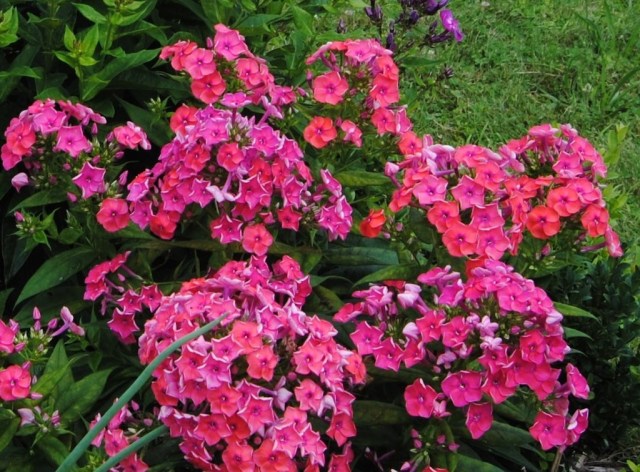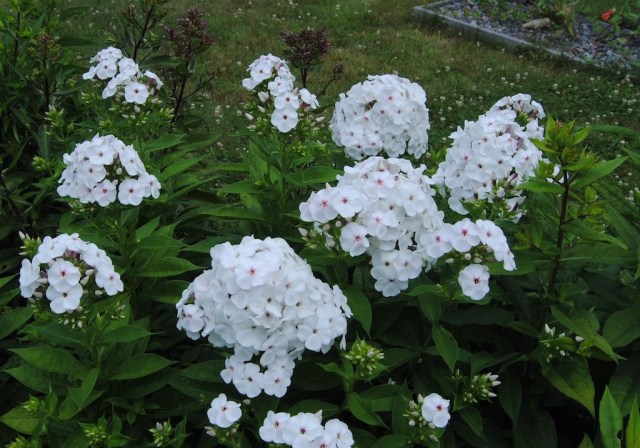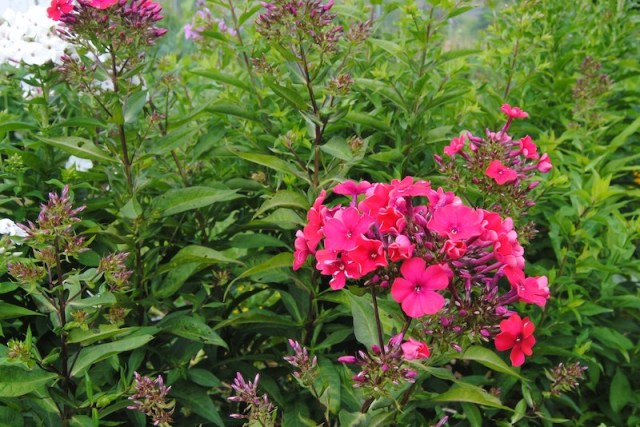The tall garden phlox (phlox paniculata) is coming into full bloom around here and I’m pleased. This smugness comes from the fact that last year I replanted several favorites into a new bed which had been dug over properly, composted, mulched, and then protected from bunnies in the spring. Sometimes effort is rewarded and this time it was, in the form of healthy, strong blooming phlox.
A better gardener would have blended them into a well thought out perennial border, mixing the colors with interesting foliage and varied forms…. but I’m not there yet. Plus I like my phlox in heavy doses. Overkill some might say.
Barsixty (coral flame is the trademarked name) is first in line. I really shouldn’t not like it but there are a few little annoying things that get to me. I think it’s too short, this is the first year it looks nice (after a couple dud years), and the edges of the blooms curl up a bit. For many gardens, the ~16inch height is perfect and the curling adds interest, so it’s got a place in my garden… but I’m just saying I like other phlox more!
I love “Laura”, it’s about two feet tall (which I still think is on the short side) but she always puts on a great show and looks good for weeks. Here Laura is in the front with phlox “Nicky” towards the back. Nicky is a little darker and booms a few days earlier. (This section has been picked over by the kids, the big dark flowers are too tempting for little flower pluckers.)
I’m kind of a snob with other plants but not with phlox. Having named phlox is great for knowing what you have (and not buying the same plant twice!) but it doesn’t guarantee a nice plant in the garden. I think this white is great, but it’s just a stray seedling that came up a couple years ago. It’s about three feet tall and although pure white is always perfect, I like the way this one has small dots of red at the bloom center and a reddish blush on each bloom stem. 
I took this picture yesterday when the clump really hit full bloom.
This one I don’t know the name for, I think it might be “starfire” but can’t say for sure. The color is great (if you like the reds!) and I like how the foliage and stems have a darker tint to them. It’s a little floppy though….. 
I need more of the clear pinks. Here is “Bright Eyes” which I got just last fall, it came as a rootbound 4″ potted plant and will probably need one more growing season before it takes off. I love the packed flower heads but they tend to hold onto dead flowers. “Franz Schubert” is just starting to the left. It’s another one in need of more settling in time.
This white seedling may still earn itself a spot in the phlox bed. It’s a short early blooming seedling which opens with a pink flush and later fades to pure white. We’ll see if it gets moved in the fall….. Phlox do well in pretty much the same conditions as any other garden flower. Even moisture, fertile soil, sun to light shade and you should be able to make them happy. In the spring I do nothing more than cut the old stems down and then come summer the only other thing I do is admire the flowers. For many gardeners powdery mildew is a problem, and I wish I had some brilliant solution but I don’t. Mildew is just not much of a problem in my yard, probably because it’s a real open, breezy location near the top of a hill. The air movement likely helps but I can’t say for sure since as we speak the monarda plants are covered in mildew and they’re just a few feet away.
Phlox do well in pretty much the same conditions as any other garden flower. Even moisture, fertile soil, sun to light shade and you should be able to make them happy. In the spring I do nothing more than cut the old stems down and then come summer the only other thing I do is admire the flowers. For many gardeners powdery mildew is a problem, and I wish I had some brilliant solution but I don’t. Mildew is just not much of a problem in my yard, probably because it’s a real open, breezy location near the top of a hill. The air movement likely helps but I can’t say for sure since as we speak the monarda plants are covered in mildew and they’re just a few feet away.
My most annoying phlox growing problem is the spider mite attacks. They build up under the leaves and suck and suck until the leaves start to look speckled and yellow. Spraying the undersides of the leaves seems to help wash them away but the best defense seems to be consistent moisture and plenty of compost and fertilizer. Dry spring weather, warm breezes (which keeps away the mildew) and stressed plants seem to just call the mites in from all around.
Another problem I’ve had (which made me leave all the phlox behind the last time I moved) are eelworms. They’re tiny worms which live in the stems and buds of infected plants. They cause the stems to distort and ruin the nice big flower heads of a healthy plant. The only solution I’ve heard of is to grow new plants from root cuttings, destroy all the old ones and find a new spot to grow phlox….. or move.
I just want to end by saying I need more phlox. I think I’ve kind of run through all the local sources and have what most mailorder sources offer, but I know there are more great phlox out there! I may have found a source at Perennial Pleasures, a Vermont nursery that specializes in heirloom plants and also has dozens of phlox varieties available. I’ve heard good things about them and it’s very likely an autumn order will show up at my doorstep.